A street lamp from the company LEDprojects. It is a big lamp, with a strong and robust mechanical screw fitting, which is of type E40. The mechanical design is very nice, the way the heat sink is integrated into the lamp. And the optical design is appealing; the lenses for every led are created with help of one piece of well formed plastic, very special.
It gives a lot of light, which is required for a street lamp. The lamp gets hotter than warm to the touch.
See this overview for a comparison with other measured lamps.
Summary measurement results
| parameter | meas result | remarks |
|---|---|---|
| ColorTemperature | 5400 K | This is bright white, close to blueish white. About the color temperature of the sun. |
| Luminous Intensity Iv | 465 Cd | This lamp is very bright. |
| Beam Angle | 120 deg | A wide beam, the value being dependent on the turn angle of the plane measured. This 120 degrees is an average value for all measured planes. |
| Power P | 31.7 W | . |
| Power Factor | 0.88 | For every 1 kWh net power consumed, there has been 0.5 kVAr as reactive power. |
| Luminous Flux | 1515 lm | A lot of light, which is needed for a street lamp. |
| Luminous Efficacy | 48 lm/W | |
| CRI | 69 | Color Rendering Index. |
| Coordinates chromaticity diagram | x=0.337 and y=0.370 | |
| Fitting | E40 | |
| Diameter | 93 mm | . |
| Length | 278 mm | 152 mm is the length of the led array, and 126 mm is the length of the srew fitting and power unit. |
| General Remarks | The ambient temperature during the whole set of measurements was 24 deg C.
Heat up effect: not observed. Voltage dependency: neglectable. For all raw measurement data follow this link (lantaarn_sp90_e40.zip). The heat sink is nicely integrated in the lamp design. The plastic plate in one piece is formed such that it protects the leds and creates a lense for every led. See also these pics. |
E_v at 1 m distance , or I_v
Herewith the plot of the average Luminous Intensity (I_v) dependent from the inclination angle with the lamp. Average here means that all Luminous Intensities measured with different turn angles but the same inclination angle, are averaged.
The radiation pattern of the lamp.
This radiation pattern shows a wide beam of light. Note that this graph shows the average of all light measurements done on the lamp (all turn angles averaged).
Additional data from the manufacturer, about the illuminated area depending on the lamp height:
20 x 8 meter (at 6 meter height)
26 x 10 meter (at 8 meter height)
33x 13 meter (at 10 meter height)
This lamp has been measured in many planes (turn angle constant, and inclination angle varied). See the next picture for an indication of the planes measured.
The planes in which is measured, with two turn angles for each plane indicated.
These are many planes, and the measurement took more than 12 hours! The reason why many planes were measured is that this lamp is not symmetrical; in the 90-270 plane there are less leds than there are in the 0-180 plane and in the 22.5-202.5 plane the most leds are visible. This results in different plots on Luminous Intensity dependent on inclination angle.
Here all the plots measured, showing the luminous intensity as a function of the inclination angle. For each plot the turn angle plane is indicated.
plane 0-180 plane 22.5-202.5 plane 45-270 plane 67.5-247.5
plane 90-270 plane 112.5-292.5 plane 135-315 plane 157.5-337.5
The luminous intensity dependent from the inclination angle, now with all turn angle measurements included.
This graph shows all measurement points taken on this lamp. There is a big variety in measurement results when taking the inclination angle constant (x-axis) and varying the turn angle (the dots for a contant inclination angle). This is, as said before, understandable as a different number of leds are seen when taking measurements in a certain inclination angle plane.
Also, the intensity under an inclination angle of 50 degrees is higher than it is at 0 degrees. This is the lens design ensuring a lot of illumination also to the sides of the street lamp. This ensures that a wide area around the lamp gets the same amount of light.
The beam angle of the light from this lamp differs from the plane that is considered. When averaging all measurements and remaining with one graph indicating the luminous intensity as a function of inclination angle, one finds 120 degrees.
The plot at the top of this paragraph shows the averaged luminous intensity values per inclination angle, which is used to compute the total luminous flux.
Luminous Flux
With the luminous intensity data as a function of the inclination angle, it is possible to compute the luminous flux.
The result of such computation for this lamp is a luminous flux of 1515 lm.
Efficacy
The luminous flux being 1515 lm, and the power of the lamp being 31.7 W, yields a luminous efficacy of 1515 / 31.7 [lm/W] = 48 lm/W.
A power factor of 0.88 means that for every 1 kWh net power consumed, a reactive component of 0.5 kVAr was needed.
| Lamp voltage | 230 V |
| Lamp current | 156 mA |
| Power P | 31.7 W |
| Apparent power S | 35.8 VA |
| Power factor | 0.88 |
Color Temperature and Spectral Power Distribution
The spectral power distribution of this lamp.
The measured color temperature is about 5400 K, equvalent to horizon daylight.
Chromaticity Diagram
The chromaticity space and the position of the lamp’s color coordinates in it.
The light coming from this lamp is somewhat distant from the Planckian Locus (the black path in the graph). This means that a correlated color temperature is computed, which indicates to what black body radiator temperature this lamp’s light is comparable. The color temperature together with the CRI determine for what specific use this lamp is suited.
Its coordinates are x=0.337 and y=0.370.
Color Rendering Index (CRI) or also Ra
Herewith the image showing the CRI as well as how well different colors are represented. The higher the number, the better the resemblance with the color when a black body radiator would have been used (the sun, or an incandescent lamp).
Each color has an index Rx, and the first 8 indexes (R1 .. R8) are averaged to compute the Ra which is equivalent to the CRI.
CRI of the light of this lamp.
The value of 69 is lower than 80 which is normally considered a minimum value for indoor usage. For outdoor use, such as this street lamp, this CRI value can be acceptable.
Note: the chromaticity difference is higher than 5.4 E-3, which means that the result might not be meaningful.
TO have a visual difference between the colors rendered with a light of CRI 85 and a light with CRI 70, see this example.
Voltage dependency
The dependency of a number of lamp parameters on the lamp voltage is determined. For this, the lamp voltage has been varied and its effect on the following lamp parameters measured: illuminance E_v [lx], color temperature CT or correlated color temperature CCT [K], the lamppower P [W] and the luminous efficacy [lm/W].
Lamp voltage dependencies of certain lamp parameters, where the value at 230 V is taken as 100 %.
The dependency measured and shown here is neglectable. All values on the y-axis are close to 100 %. When illumination differences of 20 % are just seen, here the values are much lower considering a possible lamp voltage swing of + and – 4 V (which would lead to less than + and – 0.3 % difference).
Warm up effects
After switch on of a cold lamp, the effect of heating up of the lamp is measured on illuminance E_v [lx], color temperature CT or correlated color temperature CCT [K], the lamppower P [W] and the luminous efficacy [lm/W].
Effect of warming up on different lamp parameters.
While the lamp heats up, the illuminance E_v drops faster than the power consumed. This makes the efficacy drop slightly. The warm up effect takes more than 30 minutes, but the effect is not much.

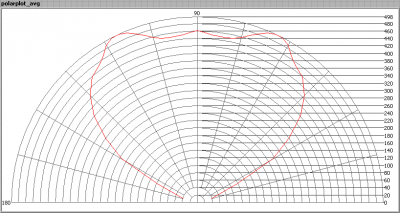
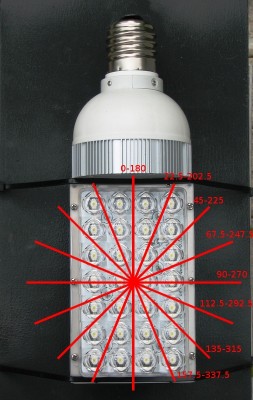








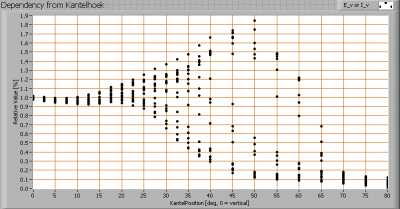
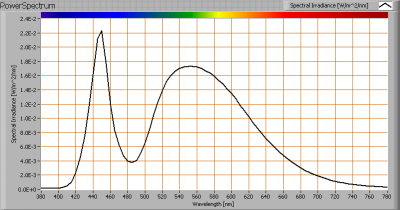

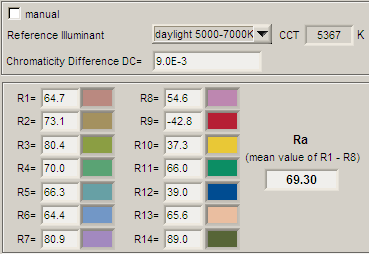
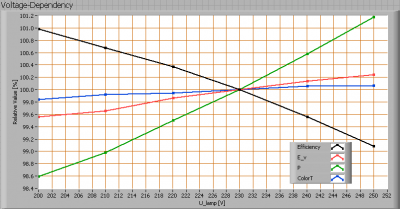
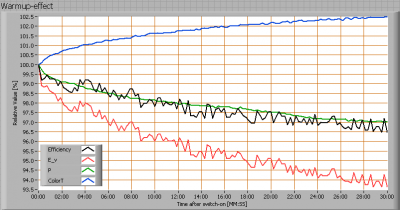
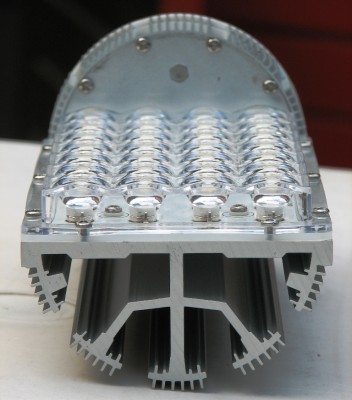
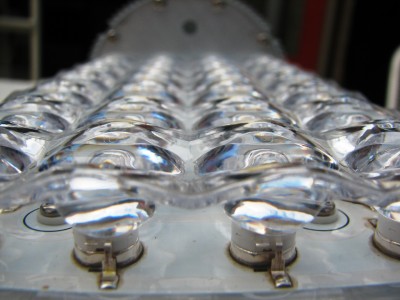



October 9th, 2009 at 3:35 am
Q Are these lights powerfull enough to replace high pressure sodium lamps 250w ?
October 12th, 2009 at 7:22 pm
Hello Jeff Preece,
We have successfully replaced them witht he 75Watt version,
and also for the 250Watt version.
It depents of your demands.
we have them more powerfull.